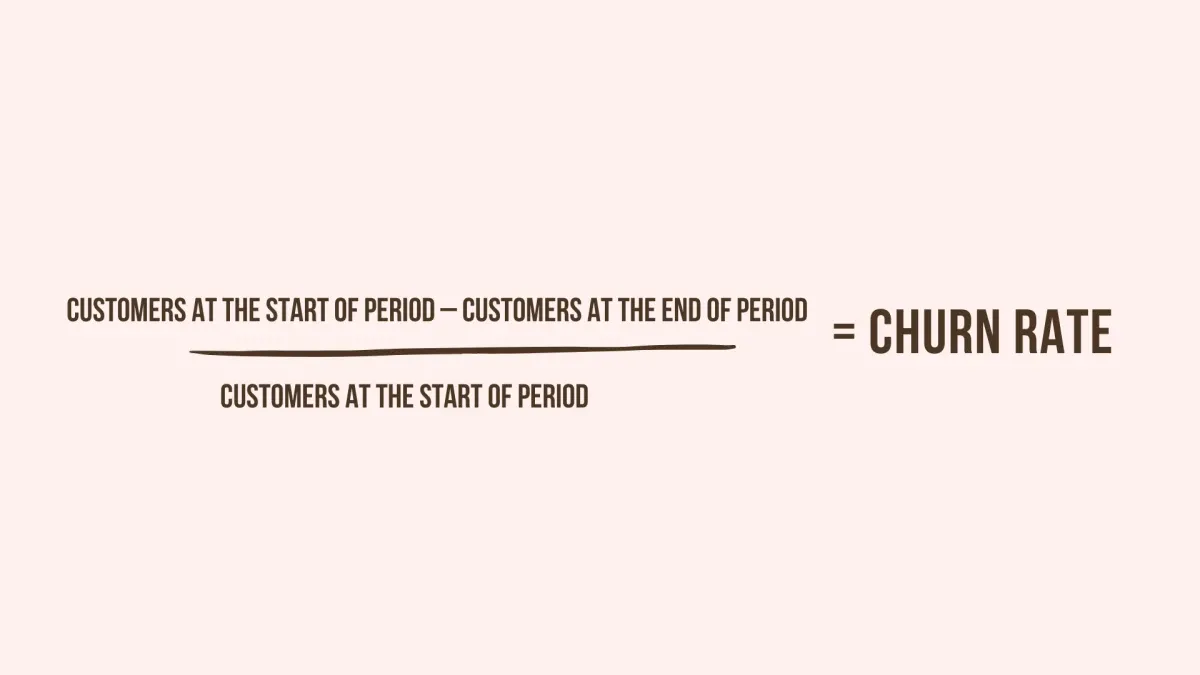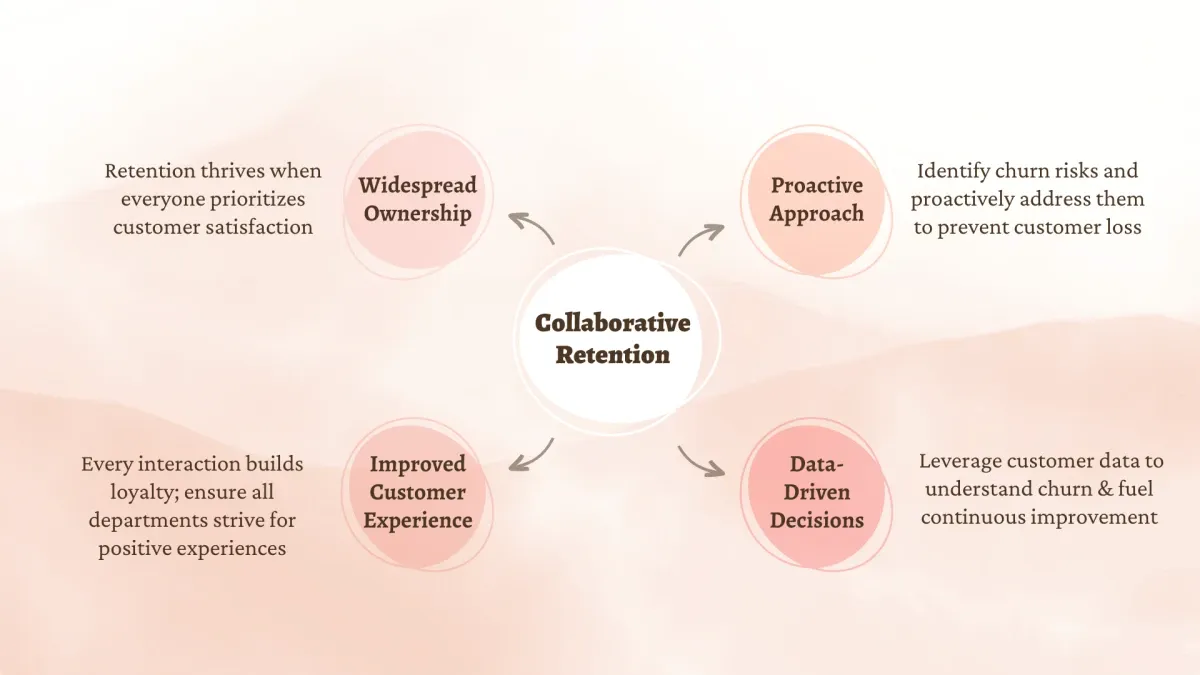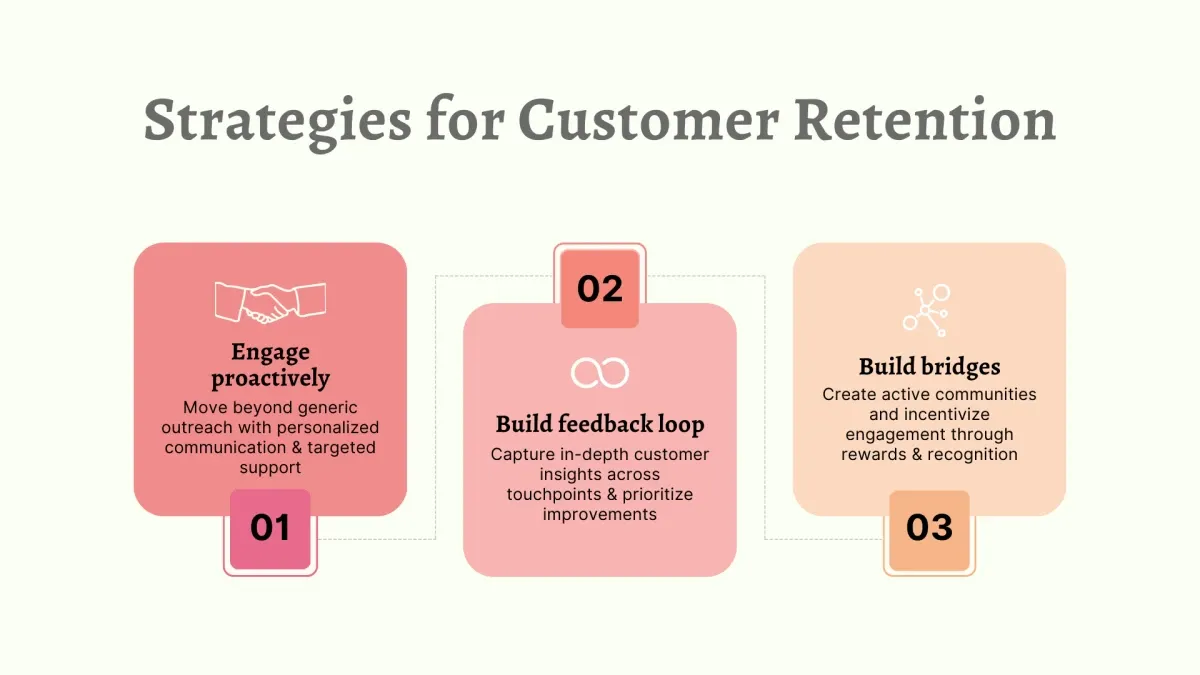Acquiring new customers, particularly large ones, is an exciting moment for any SaaS business. Everyone in the company – from developers to marketers to business leaders, feel immense pride to see customers pouring in and using a product they've spent weeks, months, or even years building and perfecting.
But sometimes, the initial buzz fades and you can hear (metaphorically speaking) the sound of footsteps fading away. Early adopters, once enthusiastic, begin to disappear, canceling subscriptions or letting them lapse.
This is customer churn, the bane of any SaaS leader's existence.
This article delves into the strategies used by retention specialists to engage and retain customers. We'll also explore whether the limitations of a single retention specialist can be overcome by harnessing the collective power of different teams.
Customer churn challenges SaaS businesses
Demystifying customer churn
Customer churn, in a nutshell, is the loss of customers who once used your product. These were people initially invested, enthusiastic, or curious – and now they're gone.
For example, say you started January with 1,000 customers. By month's end, that number dropped to 750. This decrease represents customer churn.
To calculate the churn rate, simply divide the difference between the starting and ending customers by the starting number.

In this scenario, the churn rate would be:
(Customers at the start of period - Customers at the end of period) / Customers at the start of period
(1000 customers - 750 customers) / 1000 customers = 25% churn rate
The devastating impact of customer churn
Churn is a major threat to any business, but especially for SaaS companies with recurring revenue models.
- Lost revenue: Every churned customer represents a stream of future income that dries up. This directly impacts Monthly Recurring Revenue (MRR), making it difficult to achieve consistent growth. It's a vicious cycle – high churn forces you to constantly acquire new customers just to maintain your standing, straining your marketing budget and hindering profitability.
- Wasted customer acquisition costs (CAC): When churn is high, you lose customers before you can recoup the investment made in acquiring them. This significantly reduces the Customer Lifetime Value (CLTV), a key metric that measures the total revenue a customer generates over their relationship with your business.
- Brand erosion: High churn often reflects underlying issues with your product. A poor onboarding process can leave customers confused or frustrated. Similarly, weak customer service creates negative experiences that damage brand reputation. According to a Zendesk report, a single bad customer service experience can drive up to 50% of customers to alternative options.
Guardians of retention and their arsenal
Enter, the retention specialist
Customer churn is a battle, and on the front lines stand the retention specialists. They are constantly on the lookout for at-risk customers – those on the verge of canceling their service. Their primary goal is to proactively identify potential churners before they disappear and take steps to salvage the relationship.
Retention specialists rely on a powerful arsenal of data and insights:
- Usage data: Every customer interaction leaves a digital footprint. Login frequency, feature adoption, and purchase history provide valuable clues. A sudden drop in activity can be a red flag, indicating a customer struggling to find value or facing technical difficulties.
- Sentiment analysis: Customer emotions can be a goldmine of information. By analyzing social media mentions, customer support tickets, and survey responses, retention specialists can identify negative feedback or a lack of engagement, both of which can signal dissatisfaction.
Understand the why behind the goodbye
Customer churn is a complex issue – several reasons could contribute to it. Some common culprits are:
- Value disconnect: Customers leave when they don't feel your product solves their problems or lives up to its promises. This could be due to signing up for the wrong reasons or the product itself falling short of expectations.
- Friction in the user journey: A confusing interface, technical glitches, or a slow and clunky experience can turn users away. Usability testing is crucial to identify and address pain points before they cause frustration and churn.
- The grass is greener on the other side: A competitor might offer a similar product with better features, lower prices, or a more user-friendly experience. Regularly analyzing the competitive landscape is essential to stay ahead of the curve to ensure your offering remains attractive.
Think beyond a retention specialist
While a dedicated retention specialist can be a game-changer in executing SaaS retention strategies, building a company-wide culture focused on keeping customers happy is far more effective in the long run.
Here's why:
- Widespread ownership: Retention becomes everyone's responsibility. From sales and marketing to customer support and product development, everyone is invested in keeping customers satisfied.
- Proactive approach: Instead of waiting for customers to leave, a retention-focused culture identifies potential issues and proactively addresses them.
- Improved customer experience: Every interaction a customer has with your company contributes to their overall experience. And that experience is not limited to just interacting with their account manager or customer service representative. When you have a retention-focused culture, you ensure that everyone – whether client-facing or otherwise – is striving to create positive experiences that build customer loyalty.
Data-driven decisions: A retention culture uses data to understand why customers leave and what keeps them coming back. It becomes the fuel for continuous improvement, informing marketing campaigns, product development priorities, and customer support strategies.

Think of it this way: a single retention specialist is like a single firefighter trying to put out a massive wildfire. A retention-focused culture, on the other hand, is like having a well-equipped fire department with multiple divisions – one focused on fire prevention through education and safety checks, another equipped to act quickly to emergencies, and another dedicated to analyzing fire causes to improve prevention strategies.
Customer engagement strategies
Studies by ChartMogul reveal a compelling insight: companies with best-in-class retention grow 1.5 to 3 times faster than their peers. Here are some ways to keep your customers happy so they keep coming back for more:

Engage proactively
- Personalized communication: Go beyond generic emails. Segment your audience and tailor messages (targeted emails, in-app nudges) based on user needs and behaviors. Offer relevant resources and recommendations.
- Targeted support & resources: Make it easy for users to find help. Provide a comprehensive knowledge base (articles, video tutorials) and offer dedicated account management for high-value customers.
Build the feedback loop
- Multiple touch-points: Capture feedback across touch-points (surveys, in-app forms, support tickets) and at key moments (onboarding, support interactions).
- Open-ended questions: Move beyond yes/no options and delve deeper. Use open-ended questions like “what can we improve about your experience?" or “what challenges are you facing with [specific feature]?"
- Prioritize & act: Analyze feedback thematically, combine it with usage data, and prioritize improvements. Take action (fix bugs, implement features) and communicate changes to show you value their input.
Build bridges
- Community building: Create online forums, engage on social media, and host exclusive events to foster connections and belonging.
- Customer loyalty programs: Implement reward programs and publicly recognize loyal customers to incentivize engagement and show appreciation.
Measuring success – retention KPIs and data analysis
Just like any successful product adoption strategy requires the analysis of adoption metrics, your customer retention program needs retention KPIs (Key Performance Indicators) to act as your scorecard.
Retention KPIs
- Churn Rate: This metric tracks the percentage of customers who leave within a specific timeframe (e.g., monthly, annually). A lower churn rate indicates successful retention efforts.
- Customer Lifetime Value (CLV): This metric estimates the total revenue a customer generates over their relationship with your business. A higher CLV signifies you're retaining high-value customers who contribute significantly to your bottom line.
- Net Promoter Score (NPS): This score (typically on a 1-10 scale) reflects how likely customers are to recommend your product or service. A high NPS indicates a legion of loyal fans eager to spread the word through positive word-of-mouth.
- Net Retention Rate (NRR): Often considered a gold standard in SaaS, NRR goes beyond churn to consider customer expansion. It factors in both customer retention and how much their spending increases over time. A high NRR signifies a healthy product that retains customers while driving ongoing value.
Data-driven decisions
With the help of these KPIs you derive insights to fuel smarter customer engagement strategies:
- Targeted interventions: Use data to tailor interventions. Offer additional training to infrequent users or personalized discounts to those considering downgrades.
- Hyper-personalization: Personalize communication and marketing based on behavior and preferences. Recommend relevant content or targeted discounts.
Learnings from retention success stories
Let's delve into the strategies of some SaaS companies that are winning the retention game.
Zoom
By making it effortless for users to get started and experience the product's value quickly, Zoom reduces the likelihood of abandonment before users grasp its full potential. This highlights the importance of a frictionless onboarding process that equips users with the knowledge and tools to succeed from the get-go.
Atlassian
Atlassian's project management tools, like Jira and Confluence, integrate seamlessly with a wide range of other business applications. This creates a high switching cost for users who would have to migrate data and workflows to a new platform. Additionally, Atlassian has a large online marketplace for add-ons and integrations, creating a network effect where the platform becomes more valuable as more users and developers contribute to it. This makes it less appealing for customers to switch to a competitor, ultimately leading to higher retention.
Slack
Slack's value increases as more teams adopt it. This network effect creates a situation where switching becomes less appealing, as users would have to migrate communication history and potentially convince others to switch as well. Additionally, Slack integrates seamlessly with numerous productivity tools, further enhancing its value proposition and reducing the incentive to switch.
Key takeaways
By gleaning insights from these successful SaaS companies, here are some key takeaways:
- Early value realization is key: Zoom prioritizes a smooth onboarding experience, ensuring users quickly grasp the value proposition and minimize abandonment. This emphasizes the importance of user experience in early stages for reducing customer churn.
- Network effects drive retention: Both Atlassian and Slack leverage network effects. Atlassian's integrations create switching costs, while Slack's value grows with user adoption. This highlights the power of fostering user communities and integrations to make switching less attractive.
- Integration is king: Integration with other applications enhances user experience and reduces switching costs. Both Atlassian and Slack demonstrate the value of interconnectivity within the business technology ecosystem.
- Focus on value perception: All three companies focus on delivering a strong value proposition. Zoom emphasizes immediate value upon signup. Atlassian highlights the long-term benefits of a connected ecosystem. Slack focuses on collaboration value that grows with user adoption. This underlines the importance of clearly communicating the benefits your product offers to retain users.
Building a retention-focused culture
Customer retention thrives on a collaborative effort. Here's how to cultivate a culture that prioritizes keeping customers:
- Leadership sets the tone: Executives champion retention with clear goals (reduced churn, improved NPS) cascaded throughout the organization.
- Metrics & measurement: Track progress with clear KPIs and communicate them regularly to keep everyone informed and invested.
- Investing in your people: Equip all employees to build strong customer relationships, regardless of department. For example, train sales to identify churn risks and support reps on proactive communication. Additionally, give employees ownership of customer relationships. This could involve providing autonomy to resolve issues or to go the extra mile to delight customers.
- Recognition & rewards: Publicly recognize individuals or teams who excel at customer retention. This reinforces the importance of retention and motivates continued excellence.
The path to retention is paved with collaboration
Loyal customers are the lifeblood of any business. They generate recurring revenue, become brand advocates through positive word-of-mouth, and fuel sustainable growth.
Building a retention mindset isn't a one-time fix. It requires a customer-centric culture where all departments collaborate seamlessly.
Imagine a well-oiled machine: product builds a platform, marketing attracts leads, sales converts them into happy customers, and support ensures a smooth experience that exceeds expectations. This collaborative effort creates a frictionless customer journey, fostering customer loyalty and reducing churn.
Retention specialists are crucial in this process. They work across departments to identify potential churn risks, gather valuable customer feedback, and develop strategies to keep users engaged. Their expertise empowers all departments to prioritize retention within a customer-centric culture.
By investing in this collaborative approach, you unlock the key to long-term success. Not only will you cultivate a loyal customer base, but you'll also foster a culture of employee engagement, where everyone is invested in the shared success of the ecosystem you create.

















